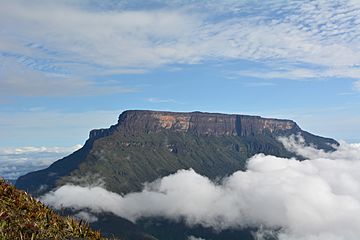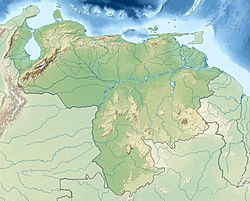Ilú–Tramen Massif facts for kids
Quick facts for kids Ilú–Tramen Massif |
|
|---|---|

Southeastern face of Ilú-tepui as seen from Karaurín-tepui
|
|
| Highest point | |
| Elevation | 2,700 m (8,900 ft) |
| Geography | |
| Location | Bolívar, Venezuela |
| Parent range | Eastern Tepuis |
The Ilú–Tramen Massif is a huge, flat-topped mountain in Bolívar state, Venezuela. These special mountains are called tepuis. It's the most northern mountain in the Eastern Tepuis chain.
The massif has two main parts: the bigger Ilú-tepui (sometimes called Uru) in the south, and Tramen-tepui in the north. Ilú-tepui is taller, reaching about 2,700 meters (8,900 feet) high. Both parts have rocky, open tops. Together, their flat tops cover about 5.6 square kilometers (2.2 square miles). They are just north of Karaurín-tepui.
Tramen-tepui was first climbed on November 24, 1981. The climbers were Scharlie Wraight and Stephen Platt. They started from the low area between Ilú-tepui and Tramen-tepui.
What's in a Name?
There's some confusion about the names of the mountains in the Ilú–Tramen Massif. Some local people, the Pemón Arekuna Amerindians, call the most northern peak "Iru" or "Ilu." But many maps show the three mountains from north to south as Tramen, Ilu, and Kerauren Tepuy.
However, other maps and books, like the "Diccionario Geografico del Estado Bolivar," name the northern mountain Tramen-tepui.
Emilio Pérez, a Venezuelan mapmaker, says that Ilu Tepui and Karaurin Tepui are part of a massif with three peaks. The most northern one is often called Tramen Tepui. But the first map of the area, made by Robert Schomburgk in 1838, called it IruTupu.
Later maps, made between 1900 and 1905 by the United States government, also showed Ilu Tepui but didn't mention Tramen Tepui.
The name Tramen Tepui first appeared on a map in 1938. Since then, it has been on many maps. But the Pemón-Arekunas people who live nearby still call this northern peak Ilu (or Iru) Tepui. This matches what Schomburgk named it in 1838.
In 2017, a team of Pemón people, led by Antonio Hitcher, tried to make sure the traditional names are used. According to Antonio Hitcher, the most northern mountain is called Iru (or Ilu). This is because it looks like a special fishing basket used to catch small fish. In their language, "Iruk" (Ilu) means a basket. "Türamen" (Tramen) means the house of ancestor spirits. "Karaürin" (Kerauren) is a tree used for weaving baskets.
Exploring the Massif
Many people have explored the Ilú–Tramen Massif over the years.
In the early 1950s, Basset Maguire, a botanist, explored the area. Adrian Thompson, a mountaineer from Guyana, also visited. Both reached the low area between Ilu and Tramen Tepui.
Videos from 2007 and 2008 show groups at the base of the mountain looking for climbing routes. They all called the mountain Ilu Tepuy. But in his 2011 book, "Beyond Ilu Tepuy," Robin Colson called the northern peak Tramen Tepuy and the larger southern part Ilu Tepuy.
Stephen Platt and Scharlie Wright's expedition in 1981 was the first successful climb of Tramen-tepui. They called it Ilu-tepui at the time.
In 1987 and 1988, American and German botanists explored the valleys near Ilu-tepui and Tramen-tepui. They wanted to study special plants called Heliamphora ionasi. Many helicopter trips were made to the plateaus in the 1990s, 2000s, and 2010s.
The second confirmed climb of Tramen-tepui happened on February 14, 2012. This was a Polish-Venezuelan expedition. The climbing team included Polish photographer Marek Arcimowicz and Venezuelan climbers Alberto Raho and Mario Osorio. During this trip, they found two new types of butterflies and a new kind of toad!
Stephen Platt's Climb
Stephen Platt and Scharlie Wraight spent four weeks climbing Tramen Tepui. Their first try failed because of heavy rain. They tried to climb the west side, right below a huge crack in the mountain.
Two weeks later, they returned and reached the top on November 24, 1981.
They hired a local guide named José Luis at Uroy Uray. He led them to Uarpa. From there, two more local people, Cecilio and Feliciano, joined them. It took four days to reach the low area between Tramen and Ilu Tepui. The local guides left them there.
On November 24, they left their tent at dawn. They climbed a steep, plant-covered slope to the first difficult part. They made a tough move up a steep, plant-filled corner to a safe ledge. Then, they crossed a half-mile-long rocky platform. They left small piles of stones and upside-down pitcher plants to mark their way. This was in case clouds came down and made it hard to see.
They went around a rock tower that blocked the way to the upper wall. They decided they had enough time to reach the top in one go.
They started climbing the middle of the upper wall at a clear spot. The next two parts were very hard. The first part was a steep, dark rock face with no easy handholds. They climbed up a rock flake to a wide ledge. The second part followed a crack in the rock to a small peak. Then, they climbed rightwards on wrinkled rocks to a grassy ledge.
The third part went straight up a narrow chimney-like crack. A rock stuck in the middle was the only good place to secure their ropes. After that, an easy wall, a small gully, and a scramble led them to the very top.
They spent two hours exploring the summit. They built stone piles and left a note with their names and the date of their climb under the biggest pile. They used ropes to climb back down and reached their tent as it got dark.
They traveled light, carrying only what they needed. They used two 45-meter (148-foot) ropes and four long fabric slings. They were able to do the climb in one day because the weather was perfect. If they had waited, the rocks would have been wet and conditions much harder.
See also
 In Spanish: Tramen Tepui para niños
In Spanish: Tramen Tepui para niños
- Distribution of Heliamphora
Images for kids
-
Western side of the Ilú–Tramen Massif (left and center) and Karaurín-tepui (right) as seen from the Gran Sabana.




